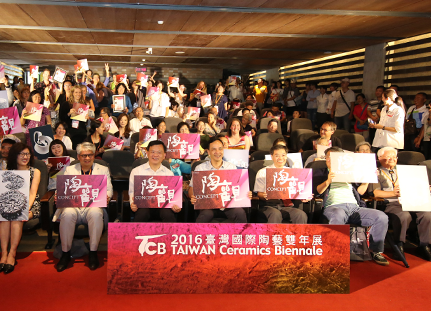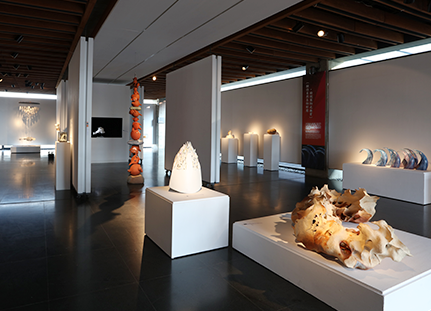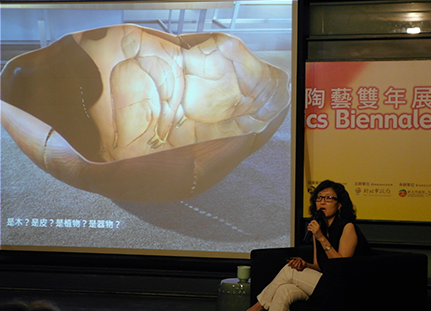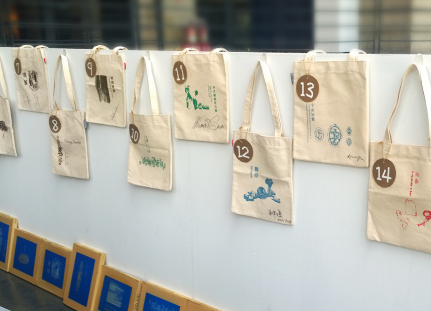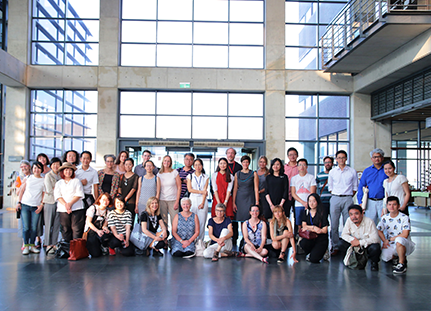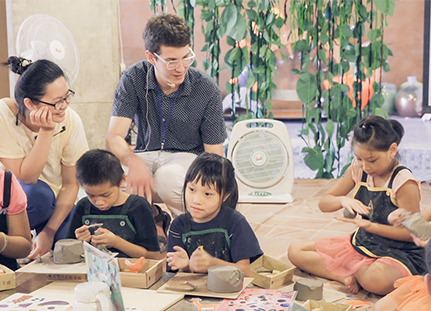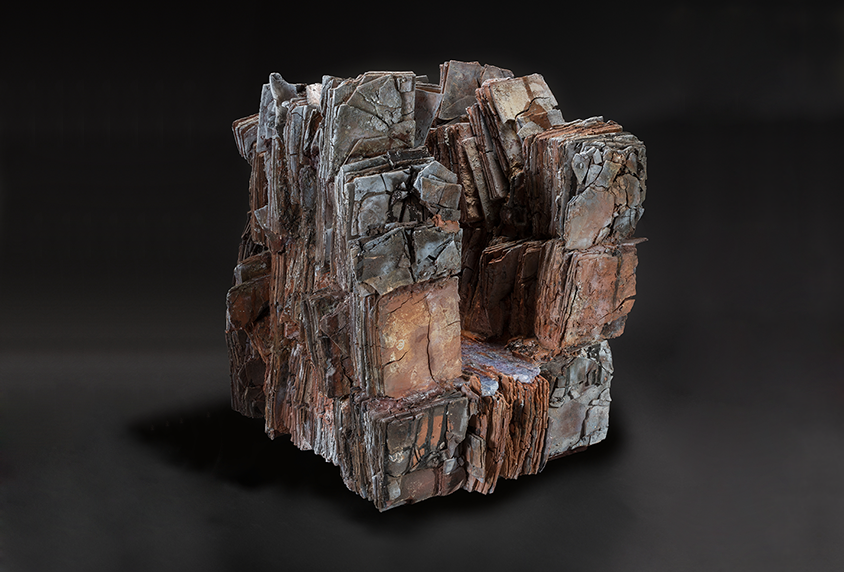
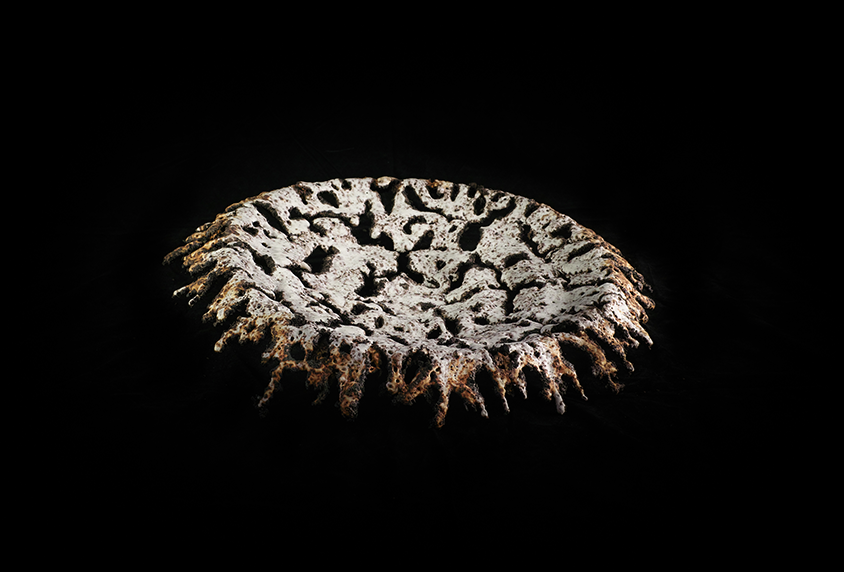

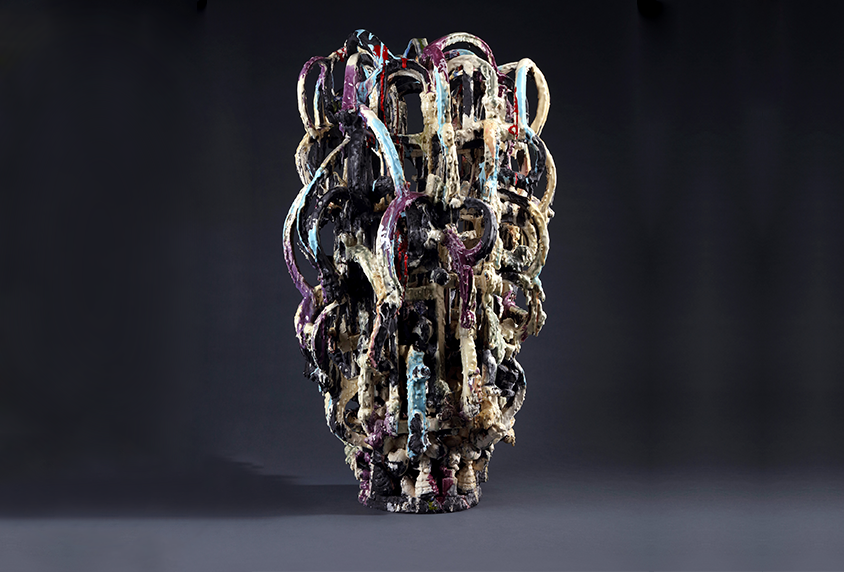
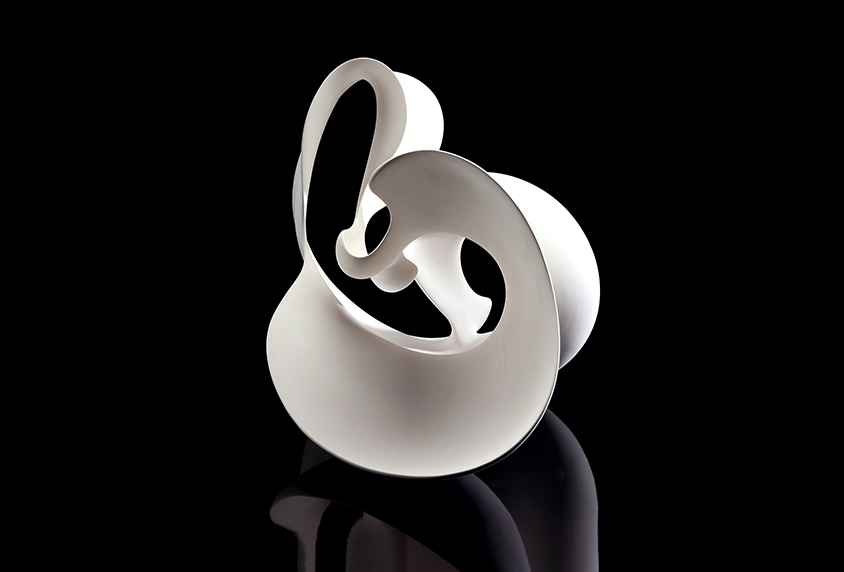
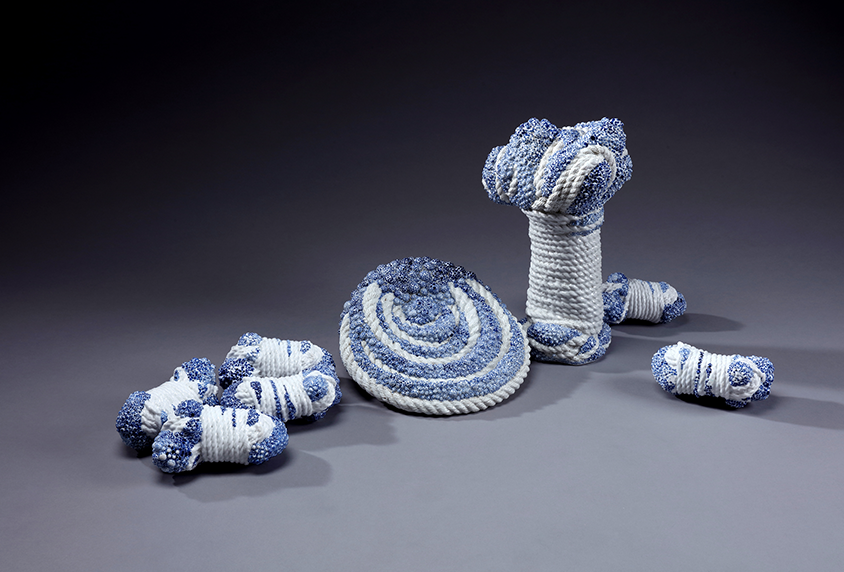

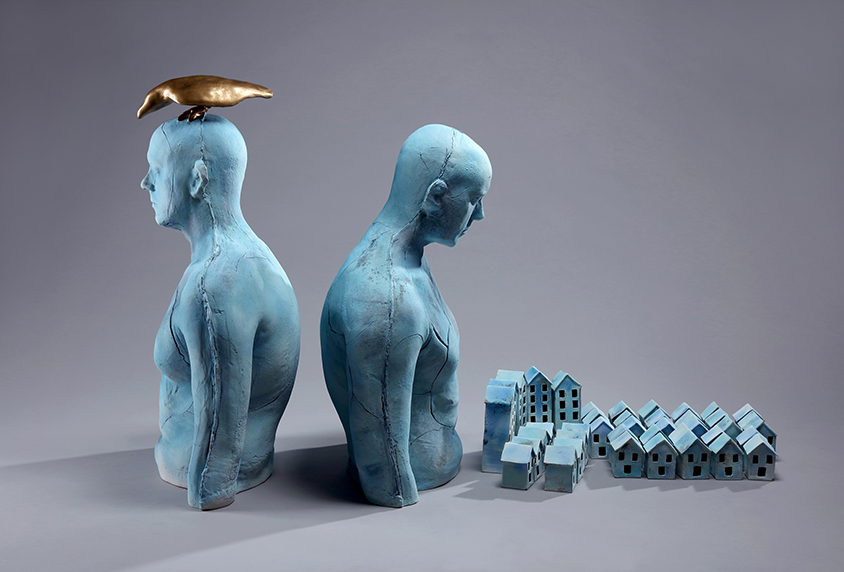
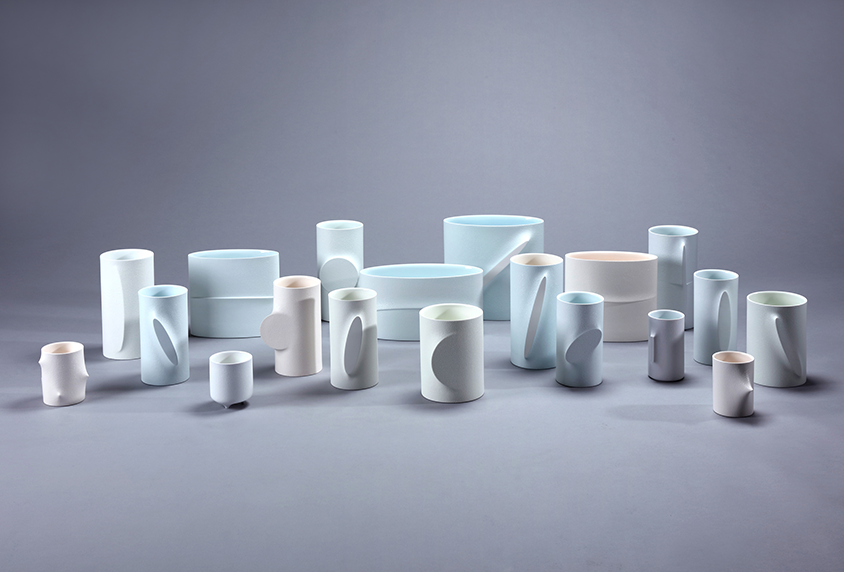
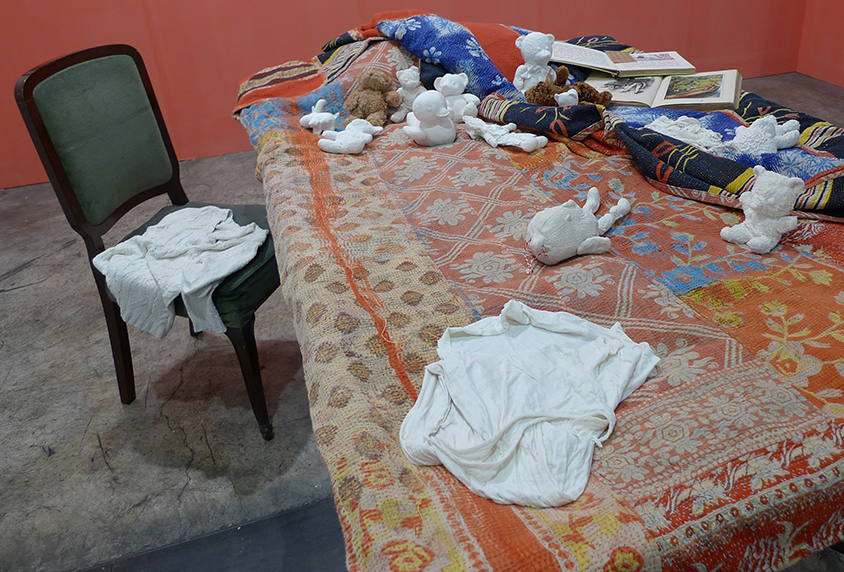
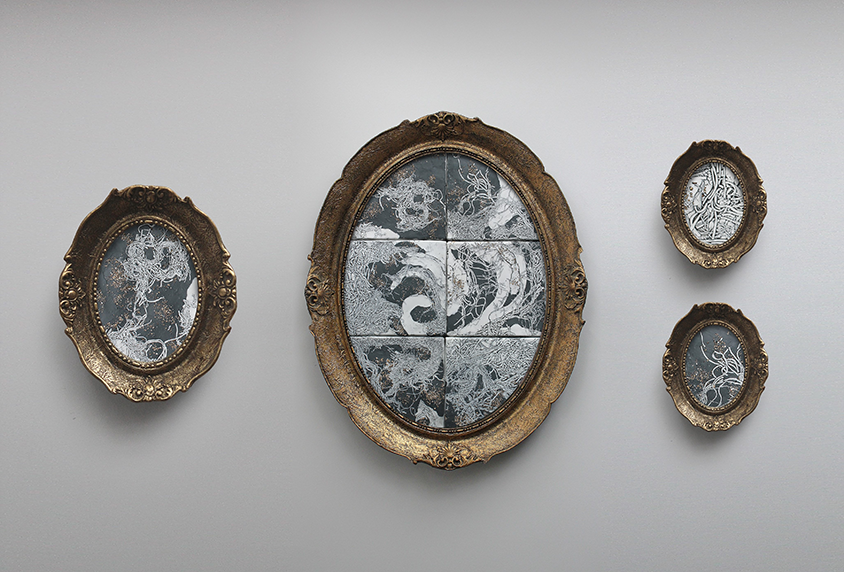
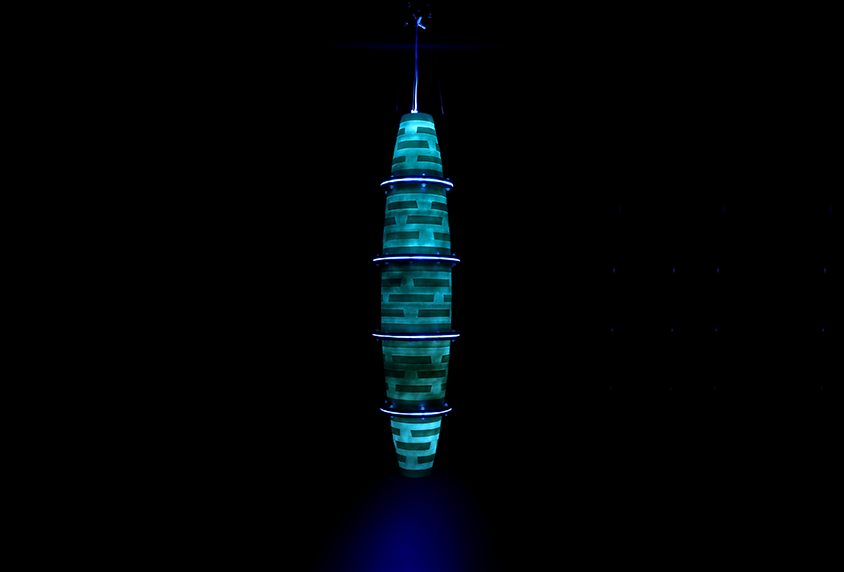
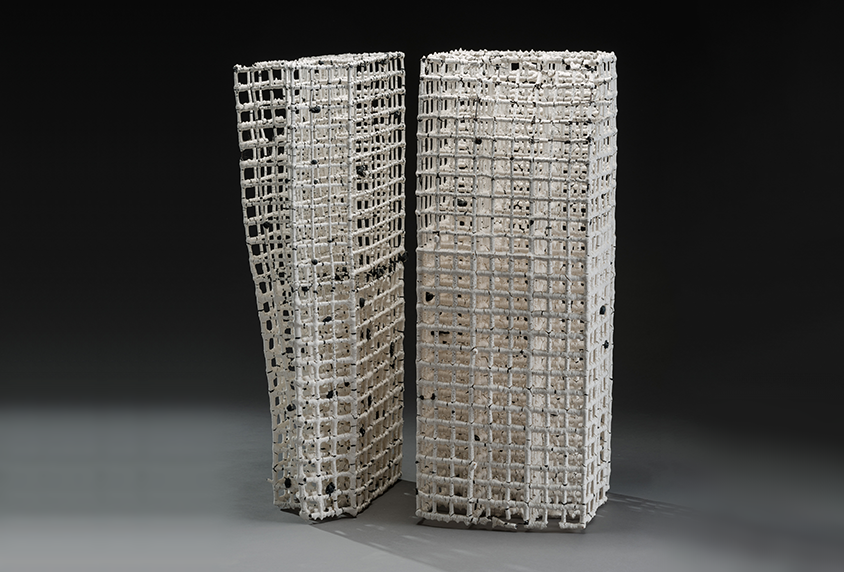
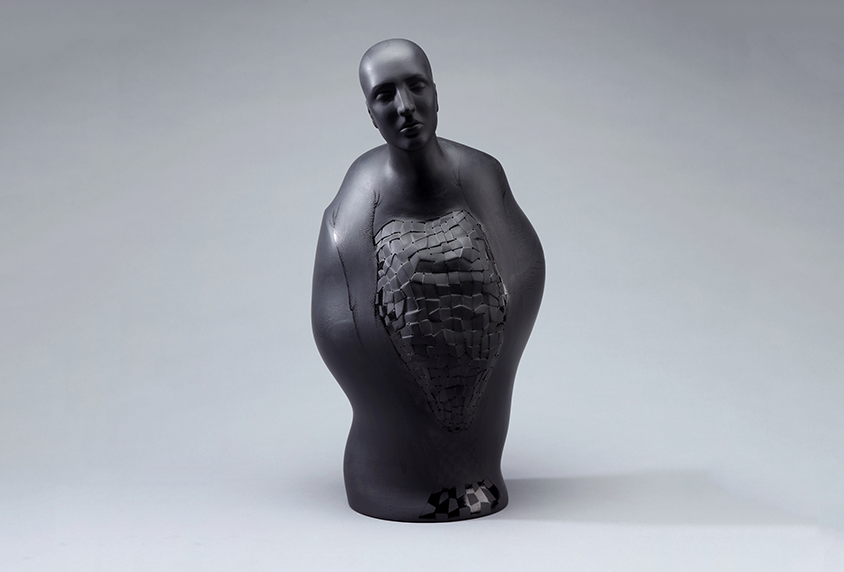
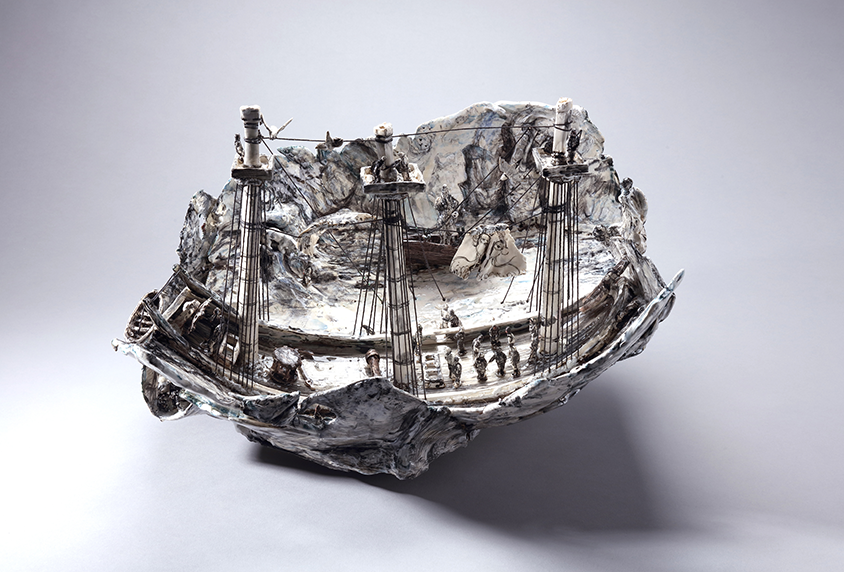
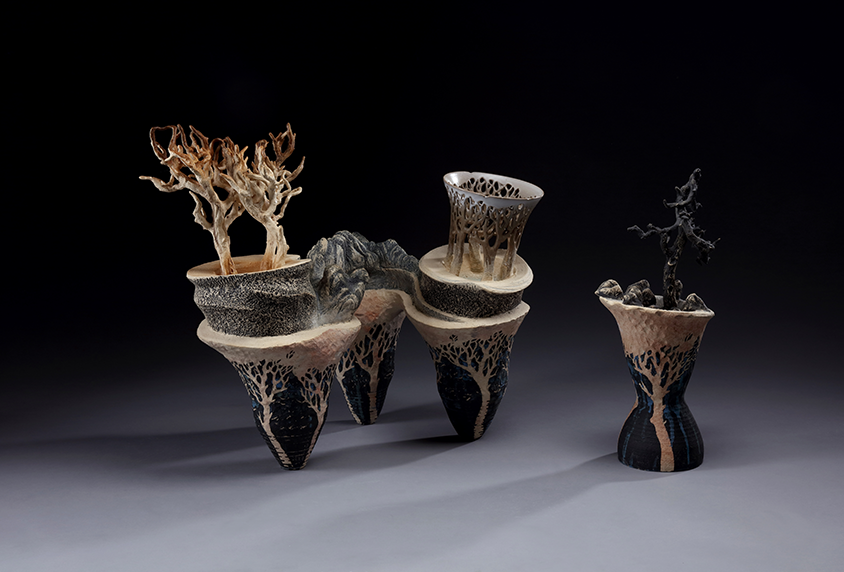



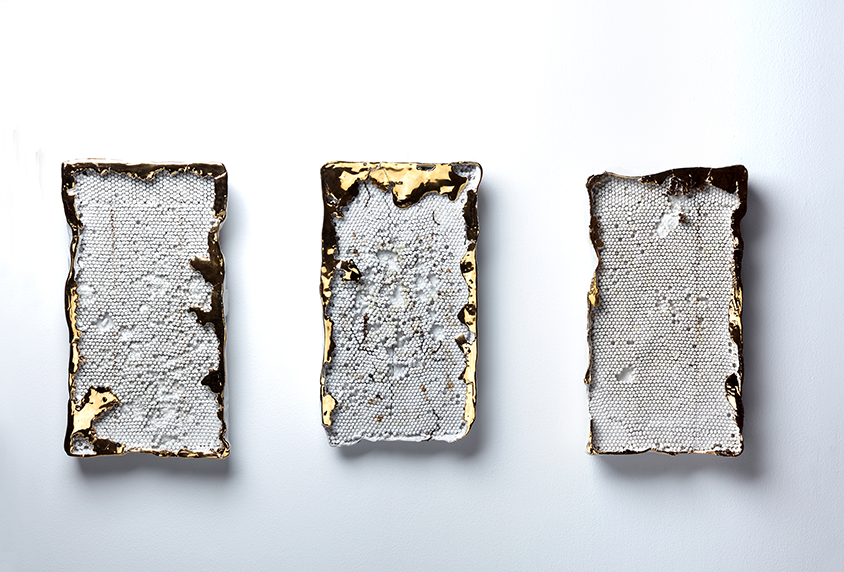




















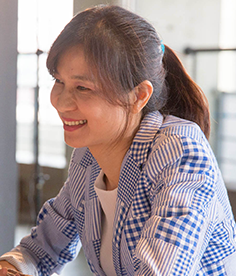

Taiwan Ceramics Biennale is a prestigious international exhibition organized by New Taipei City Yingge Ceramics Museum every two years. Since its inception in 2004 the Biennale has attracted enthusiastic participation of local as well as international artists. The 2016 Taiwan Ceramics Biennale, after years of preparation and with the international jury’s professionalism and fairness, demonstrates the unlimited possibilities of ceramic art and the perfect integration of fine art, aesthetics and materials.
The theme adopted by this year’s Biennale is called “Concept”, which indicates the encouragement of contemporary ceramics art, the solicitation of art concepts, the emphasis on pottery-based creative process, the manifestation of rich, diversified and ceramic-oriented creations in Taiwan, and a channel of bringing Taiwan’s ceramic art to the world. Most of ceramic artwork renders an artist’s concept directly through clay. The key of the overall development of a piece of art is the application and management of various materials—which is also a crucial element in the charm of ceramics and artist statements. To widen and deepen the engagement of ceramic artists, the 2016 Taiwan Ceramics Biennale offers two Grand prizes and two Gold prizes and awards the residency and solo exhibition in the hope of highlighting the creative spirit in the competition.
There are 369 entries from 48 countries applied to the 2016 Taiwan Ceramics Biennale, embodying the evolution and concepts of ceramics around the world. All award winners and finalists are excellent and represent a variety of unique styles. Among all, Clay and Nostalgia15 TWT-02 are unanimously selected by the jury as the two Grand prize winning works. Clay—centered around soil—overturns traditional ways of thinking and portrays the intriguing engagement of and interdependence between clay and glaze. Nostalgia15 TWT-02 expresses harmony and adaptability between clay and non-clay materials and creates a dialogue between the past and the present by cleverly incorporating glass into unfired roof tiles made of Taiwanese local clay. In addition, Destination V is a richly sentimental and impressive sculpture in the form of the human figure. It creates a familiar three dimensional visual image with strong and tense expression/performance and gives its viewers unlimited room for imagination.
The definition of ceramic art evolves in response to the changes of the environment, society and time. The form and expression of ceramic art also diversifies. I believe it is worth contemplating that ceramic art may gradually lose its original characteristics and value in the face of global trends in contemporary ceramic art and the popularity of contemporary multimedia art.
Over the years of organizing Taiwan Ceramics Biennale, New Taipei City Yingge Ceramics Museum has brought Taiwan in line with global development of ceramic art and has enriched its exhibitions and collections. It is my hope that the museum will continue to introduce new thinking of ceramic art around the world, and show art trends and creative energy in Taiwan and from the international community. It is also my hope that an exhibition space will not only be a place where pieces of art gather but also be an international platform for dialectics and exchange of creative arts philosophy.
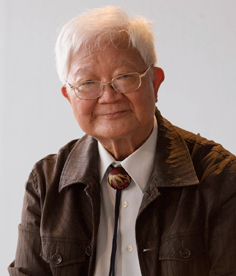

The jurying process for the 2016 Taiwan Ceramics Biennale for me is like three round-the-world intellectual journeys of ceramic arts. During the first journey I gave a quick glance at 369 entries from around the world. In the second one, I dived deeper into those pieces of art and categorized them into three levels of grades, i.e. 2, 3 and 4. During the third journey I embarked on my in-depth review of all entries in grade 4, picked those outshining the others, and put them into grade 5. My past jury experience told me that the majority of ceramic artists, both domestically and abroad, are young, and that young artists usually focus on shapes, concepts and creativity, and have great skills and techniques—but there’s room for improvement in terms of leveraging materials.
Art exhibitions are intended for viewers to appreciate art, to have heart to heart conversations and soul connections with the artwork, and to learn artist’s amazing creative ideas and techniques. In the 2016 Taiwan Ceramics Biennale 119 pieces of art are selectively chosen out of over 300 entries to demonstrate their own characters and beauty. Among all there are two I’d like to especially commend for their creativity and ingenuity.
Oroshi is composed of two clay bodies placed side by side and bridged by glaze. Because of its fluidity, the glaze over the two clay bodies flows down during firing, accumulates in the gap between the bodies, and hence connects the two clay bodies to one piece.
Clay is a piece of art of which the main body is the glaze and where support of a clay body seems unnecessary. In fact the artist used a clay body as a support vessel and sprinkled high heat resistant clay powder on it before glazing. When the work was cooled down after firing, the clay body separated from the glaze as may be expected, consequently making the glaze the main body of the work. The creative concept is original and beyond tradition, very much worth learning for ceramic artists.
Entering the twenty-first century, we have more creative advantages than ever before and thus would expect even more astonishing artwork. The entrants of the 2016 Taiwan Ceramics Biennale have shown their amazing designs, creativity, concepts and techniques. Still, I believe the artists haven’t fully taken all the advantages which didn’t exist in the past centuries. For instance, firing electric kilns, firing gas kilns, precision instruments for reduction firing, the use of Seger formulas to know the exact composition of the raw materials, precision instruments for oxidation firing and reduction firing, ceramic materials with greater heat capacity, and etc. I believe that when artists make use of all of those available benefits even more wonderful ceramic artwork will come.
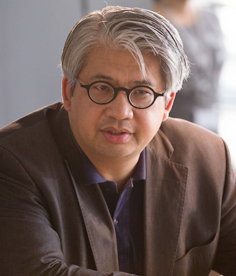

Of the many (ceramics) biennials in the world, the Taiwan Ceramic Biennial is one of the most prominent and one of the most highly respected in the field. This is due to the excellent organisation, the beautiful catalogues, the impressive New Taipei City Yingge Ceramic Museum and, naturally, the many excellent, exceptional participants in the exhibition.
Recent editions have opted for a system that alternates between an artists’ and a curators’ competition. For the 2016 event, artists submitted work in 2015 so that the jury could select those works that will go on show for a wider audience and which of these are slightly more special than the others. It is an international competition. This entails judging entries from around the world with a ditto jury. This set-up with entries from dozens of countries means the entrants are heterogeneous. Differences in age, skill, artistic background, geographic-historical consciousness and naturally the many idiosyncratic personalities make the competition lively.
All the entrants have one thing in common: they wish to play a role on ceramics’ global stage. And that is truly ambitious as the ceramic art – just like athletics – is practised around the globe because it seems so easy, you don’t need much to do it and it’s functional. However, in contrast to athletics it hasn’t been around for 2,000 years, but for over 10,000 years. This means ceramics competitions are framed by all historical periods on all five continents. Alongside ambition, ceramic artists also need the guts and perhaps glasses with blacked out lenses so they can’t see everything that has come before.
The 2016 competition has brought a large number of exceptional works together. The first round is image based and is juried remotely using iPads and iMacs. This means the entrants’ visual quality is an initial criterion. You can’t feel, touch or oversee the finer points; you primarily select on the basis of visual appearance, image strength and you try to assess the technical quality from afar.
The next round takes place with the works in Taipei. The inspection of the over 100 pieces that made it through the first round is impressive. Together these works constitute the 2016 Biennial’s main exhibition. Now we can view the works in real life and together. This is when the big struggle starts. Fortunately, the jury has multiple days to decide. This is important because some works are quiet, reserved and only unveil their secrets after a while. Others are brash, good in pictures, but annoying, pushy types in real life. The selection of works has provided global variety. This ensures that the criteria for good ceramics, that are different on every continent, in every country and at every school, become fluid and this creates a new, strong voice for the 2016 jury. This jury is experienced, diverse and always capable of discussing multiple sides of an opinion.
Are there new developments discernible in these works? Is technical development the focus, is it about eternal beauty or are the ceramics a game of bowl and vase? Can you see that the works were made with knowledge of art history, the history of ceramics and a sense of contemporary urgency, is that even an important criterion, are urgency and originality not typically Western criterions and craftsmanship an Asian one? The jury discusses, considers and oversees.
The eventual winners are slowly distilled over multiple rounds. My personal criterion that important works today should reflect what it is about in the 21st century is widely addressed by some works, yet not at all in some prize-winning pieces (but they are so beautiful!). What I noticed was that sustainability − major societal issue − played a role for a large number of the first ten nominees. The game of decay, the circular city, re-use, the putting back together of our society is not something that can be ignored in 21st-century artworks.
A special attention is asked for the Polish artist Stanislaw Brach. He uses several techniques and ideas in his work Gold. Porcelain honey combs are almost imperfectly reproduced with molds, and in some way restored with gold. Needless to say that this metaphor for human society reflects not only environmental destruction, but also the need to take care for nature. The Japanese kintsugi method is a hipster way to restore in an even more fashionable way.
Kojima Osama from Japan and Wu, Yu-pei from Taiwan provide the biennial with two major winners who honour this competition’s reputation. These two artists, will, like the other winners, be retained in our collective ceramic memory for all eternity.
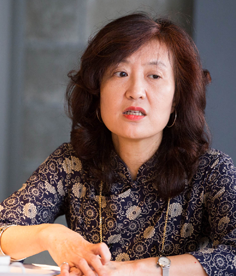

For Ceramics to be Ceramics
I—with various experiences in contemporary multimedia art, installation art and as an exhibition curator but no ceramic art background—first need to be aware of the contributions I can make as a juror toward the jurying process in which expertise and knowledge of time-honored craftsmanship is much needed. At the same time I need to pay closer attention to the contemporary development of craftsmanship and contemplate the question: What is the value of traditional craftsmanship in today’s society, life or aesthetics? This is a question to be asked continuously and one that will never have a final answer. Only through artists’ creative practices can we be pleasantly surprised at and have a deeper understanding of the potential and value of traditional craftsmanship. In this sense, I’d say that good works of art are those which go beyond traditional boundaries, surprise and reflect what’s happening, and show that they are ceramics but not of ceramics.
The Value of Diversity: The Majority Decision and Recommendation Prizes
There are no set criteria for the judging of the prizes. It is left up to the jury to reach award decisions by majority voting. As a
core value in the Taiwan Ceramics Biennale, diversity could be perceived through a diverse range of backgrounds of the jurors—
working as an arts practitioner or a museum professional from both domestically and internationally, Asia and the Americas,
academia and industry. It is expected that the jurors with different values in different fields can collectively determine a diverse
list of winners. In fact, of course, this expectation is difficult to fulfill, especially in the later phases of the jurying process, because
after all award decisions need to be based on rational discourse and dialectic. However, rather than putting contrasting “samples”
on one plate, the jurors interweave and exchange ideas and subsequently testify to the rebirth and breakthrough of ceramic
art—which I believe is the greatest reward for every participant. Furthermore, through the selection of Recommendation prizes—
which are like top picks for connoisseurs, each juror is able to share his/her personal tastes or views of what art should be—
some favor romantic designs; others are for the use of satire, ridicule or speculation; and still others, skills or fun. Even though
the award decisions for Recommendation prizes are also anonymous and of majority voting, but they truly demonstrate the
realization of the value of diversity in modern times.
Creative Content Rooted in History and Traditions
Ceramics is inseparable from everyday life. Functional qualities and aesthetic expressions are always the two ends of the
spectrum of ceramic creation from primitive culture to modern civilization. In the 2016 Taiwan Ceramics Biennale the entrants—
even though from various regions and cultures—somehow seem to have reached a consensus on what issues to be addressed:
inspirations of and confrontations against the quality of clay, commotions about glazes and surface treatments, struggles
between vessels and sculptures, sophisms of seeming or unseeming appearance of ceramics, balance between shape and
structure, and comparisons between exquisite simplicity and extreme complexity. Some entrants are extremely meticulous and
nearly obsessed with handcraftsmanship, others allow their artwork to prove its value over time, and still others present pieces
which amazingly extend and expand into space. Nevertheless, hand building and throwing remain as basic skills, and techniques
of slab, slip casting and montage of material are employed to sway the nature of clay. The growth of and the stand-in by
modern digital technology is an unavoidable reality yet it won’t necessarily and effectively pacify craftsmanship breakthrough
anxiety. Lastly, failures of emulation and platitudes of symbolization are at all times pitfalls involved in art competitions related
to traditional forms of art. If historical perspectives are discarded, materials are misused, and the cultural-linguistic context of an
issue is neglected, ceramics will no longer be ceramics.
Inner Self, Meander 2 is a simple retro-style hand-pinched ceramics akin to a legend of the primitive time. I voted it for Recommendation prize because of its easiness, effortlessness, childlike innocence and genuineness. Yet it has its pompous attitude with a surreal, dream-like appearance, which is almost like a Chinese ink wash painting. It seems to be a set of functional containers but it’s not. It appears to be a landscape penjing but it’s lifeless. It is simply a coagulated mass of the universe, or a frozen moment of the flow of slip.
I’m not a ceramic artist, but Inner Self, Meander 2 stirs up my interest in pottery. It carries the legacy of clay and awakens the instinct of hand-building. It is pottery modesty, narrative elegance and handmade nature. Its presence is complete yet fleeting.
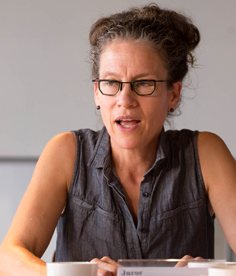

2016 Taiwan Ceramics Biennale’s goal of “summoning the sprit of passion for ceramics” includes an international group of artists working with traditional tea ware, design based tableware, conceptual vessels, large and small-scale figure modeling, space-based installations and monumental sculpture. Across the range of genres, artist statements address overarching philosophical issues of humanism and social/political/cultural conditions. There exists a prevailing sentiment among the artists that creative work which illustrates or represents the human condition – autobiographical, biographical or more broadly narrative - generates agency for change and becomes intervention. Other artists exercise personal opinion/experience to appeal to like-mined individuals. Some narrative based work relied on a naïve, plastic use of material to remove imagery from, and place it in, reality. This could be a response to the contemporary proliferation of ceramic material recently included in the oeuvre of established (non-ceramist) artists. In this the manipulation of the clay itself, at times, is more expressive than, or at odds with, the imagery. Just as one could describe some of the work as strategically or circumstantially ‘deskilled’, also evident was notable submission of works with a flamboyant display of material virtuosity. So, we see both a highly refined material process that expresses one type of human will, and use of the material in a raw state, barely removed from its primary geological habitat – which tells another story of human nature and will. Figurative sculpture rarely pursued realism in this group of work, but more often was expressionistic or used narrative devices such as puppet/doll or caricature. This approach may be a reaction to negotiating contemporary imagery, or the contemporary networked/ distributed self. In the greater group, submitted work is executed entirely or primarily in ceramic materials - well above the ceramic qualification in the prospectus and not often the case in such a broad call for entries.
Time, culture and the visceral engagement of material phenomena are interrogated in the artwork of the top four prizewinners of the New Taipei City Yingee Museum’s 2016 Taiwan Ceramics Biennale. Issues driving this work have underpinnings of social political critique embedded in content that is at times dire, but also contains moments of levity on almost all accounts. Nostalgia15 TWT-02 operates sculpturally as an object/artifact that insists on being read archeologically and commenting culturally. Constructed of unfired Taiwanese roof-tiles fused together, this dense mass not only belies the volume that a shelter might offer, but arrests any impulse to imagine. The acronym TWT in the title offers some relief. In Clay, the measure of time uses phenomena to differentiate ceramic structure and viscous surface. This abstraction arrives at a technical intrigue of materials or, if you prefer, a frozen animation. Half Frame Montage and Anthropocene use current ceramic tropes to spin ‘not dissimilar’ ideas about humanity and ceramic materials – the later of the two using formats of quotation, de-skilling and acrobatics to enliven a traditional notion of sculptural space in an unconventional manner. If the residency and solo exhibition awarded these artists bring their practice into proximity for a period of time, the potential discourse between objects and individuals might instigate surprising collisions and unlikely collaborations – a completely circumstantial but most productive outcome for this recognition of their work and practice.
The Candidness of Absolute Zero and Nirvana are the two Silver prizes and also include residencies. The first of these works - not to be confused with a Mobius strip, although the title might tempt this association - is not only ‘orient-able’ but impresses as a virtuosic feat of material manipulation. Nirvana, on the other hand is a fable or allegory whose fabrication renders objects that read as both playful and ‘worried over’. The resulting pieces, soft subjects rendered in hard material, are hard to focus on visually but otherwise clearly identifiable. The methodology becomes a primary bearer of content as it impacts the experience of ‘seeing’.
Waiting For Godot, in all its abstraction and systematized mathematical toiling, is ironically powerful and visceral, although the bottomless form that reports as a storage vessel might undermine this impact on two counts. Ode To A Not Too Distant Past, awarded the other Bronze prize quickly tells its tale of human folly.
New Taipei City Yingee Museum awarded five Merit and seven Recommendation prizes. To mention one of each category: Between Beyond (Merit prize award) offered a smart, excellently crafted, engaging group of cast vessels whose abstraction and formalism ‘push’ conceptually against the acuity of human perception and interpretation with grace. Recommendation prize winner, 9 Serving Vessels, also a consortium, are blatantly titled to suggest a tactile, quotidian application of service while remaining rather oblique regarding just the what the ideal function on the table might be – a strategy whereby one must invent the form to find the function, or visa versa.
Viewing dimensional artwork from images on a screen, the first step in the jurying process of competitive international exhibitions, is never ideal or easy: scale is only available through a projection of metrics; color is filtered; image resolution can make details of surface finish and touch obscure; the preposition of the object relative to the site is ambiguous. The gathering of jurors at the New Taipei City Yingee Museum for the final selection of prizes, in the presence of the submitted work and in the presence of colleagues with expertise in the field from around the globe, furthers the Museum’s aspiration and essential commitment to making connections between people, places and ceramic art worldwide.Thank you for this opportunity


An Astounding Encounter
The jury of the 2016 Taiwan Ceramics Biennial, with expertise from around the world, deliberates over multiple dimensions of an opinion, seeks maximum consensus in the selection process and launches a series of dialogues with the astounding entries. The jurors are honored to have experienced a group of award winning works beyond average standards of quality and exploring diverse issues.
I’ve paid attention to Kojima Osamu’s artwork for about a decade but it was not until five years ago I saw his works in real life. I was astonished by their immense volume and dynamic contrasts, which were barely rendered in photos. When I stood quietly in front of Kojima’s pieces I could feel the traces of wrestles and symbiosis between the artist and clay. His creation records the symbiotic relationship between man and nature. Whether about soil under the asphalt surface of a road or about people’s houses, his works not only reveal evidence of construction and destruction but also underline the consequences of the confrontation between man and nature in the course of time and natural erosion. Rather than heavy solid clay blocks in most of his previous works, Nostalgia15 TWT-02 is constructed of embryonic clay roof tiles manufactured by a factory in Liu Jia, Tainan City, Taiwan. It is similar with his previous works in the manner of stacking of homogenous forms, emphasis on the energy of clay, and historical reflections on man’s existence in nature and man’s adaptation to his physical environment. Yet it further reveals more details of delicate aesthetics of ceramics, obscures the traces of wrestling against clay, and centers around the harmonious symbiosis, coexistence and interdependence of hardness and softness.
Anthropocene, by American artist Kosmas Ballis, in its abstract as well as narrative form, is not only an instigation of visual arts but also an invitation to viewers’ dialectical thinking. Dissimilarity between flamboyant colored glazes and black matt glaze, movement and stillness, this work of art is a statement of polar heterogeneity as it harbors flowing glaze covered figurative objects among overflowing abstract lines. It is wild, gorgeous, tense and uneasy. Its strong visual tension keeps a viewer’s attention fastened. Its structural form navigates the balance between positive and negative dialectical ideas. In fact, Anthropocene not only achieves a strong visual impact of end-time unruliness but also thoughtfully praises a new era of the birth of life.
I’m not unfamiliar with Ilona Romule’s artwork but failed to recognize her work Black Squares in the jurying process. Black Squares, with a height of only 20cm, is a dense mass of which the existence is hard to be ignored among many large-scale entries. It is created with the use of her well-known techniques of self-made plaster model moulds and slip cast. However, different from her usual hand-painted White porcelain or black and white works with narrative painting in overglaze technique, this porcelain figure has black delicate lines painted on its black body, so subtle, restrained but elegant that one could easily miss them. Its mosaic decoration is her interpretation of ancient mosaics observed in her trip to Israel. The marriage of human figure and vessel is an analogy that the human body is a vessel. Inspired by ancient Roman remains in Israel, Black Squares connects the dots across the borders of space, time, history and culture.
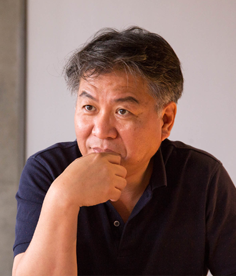

Today’s Contemporary Art is very complex enough to be in a deadlocked state beyond the differentiation and assimilation between genres.
Even in the midst of these vortex, traditional form of works are existed, however, it is the fact that new creation paradigm of artists, who follow conventional wisdom and social awareness, is tinged with very aggressive and challenging aspects.
How about the case of ceramics? Competition would be the most convenient means to verify trends and patterns of contemporary ceramics. Since prize money and honor are at stake in competition, many artists and emerging artists do their best to submit their work in order to win.
Nevertheless, the numbers of applicants were small compare to Japan’s Mino Competition and Korea’s Ceramic Biennale, also it was unable to discover work that is highly-developed or has potential in this year’s Taiwan Competition.
In particular, there were many abstract sculptural works, while there were only a few works which were centered on the contents. Abstract without purpose. In other words, most works seemed focused only in completion of making, stuck to material and its physical properties. It was hard to find works which show artists’ unique experimental spirits or formative issues.
Similarly in contemporary art, the current contemporary ceramic is expanding the scope of the expression in both form and content, however, why does such work is rare in the competition? Some works have theme of human life and its reality, but it was not sufficient in expression and subject consciousness.
Eventually works that are based upon material and its physical properties won the prize, but it was not possible to discover other exceptional distinctions compare to previously attempted methods. In addition, some works’ structure and form were the impressions that were almost plagiarized from existing works.
The most concern is participation of professional artists who already built their own style of work. Since they have their own know-how in fabrication technique, forms and contents, of course, their works are much superior and distinguished compare to the works of emerging young artists.
Good works touch viewer’s heart without description. Work that tacit knowledge is bound by artistic courage and deep training would become detonator for the evolution of contemporary ceramics.
The Jury Prize was Lady Franklin's Dream – Sycorax, the historical event of sponsoring seven expeditions to find the fate of her husband John Franklin who was lost during the 1845 arctic expedition.
If you don't understand the background of this work, the work is seen as flimsy sculpture of people in a boat with three sails. In fact, work production skills do not seem high, and there is no implication of the historic expedition of John Franklin. Nevertheless, this works is selected for Jury Prize because there was an atmosphere that is unusual compared to other titles of works, including grand prize work. This work seemed to have clear motivation and purpose compare to other "abstract without purpose" works as mentioned before in commentary.
It is difficult to express subject such as historical fact, social phenomena and personal issue using the medium of clay. Unlike painting and sculpture, a representation methods and techniques is still a high priority in "ceramics" which is blocking the expression consciousness with progressive insight of artists.
Greek earthenware Amphora is famous for its elegant shape, but we should not forget that the drawing of myths and epic painting on the surface makes it more valuable.

Established in 2004, the organization of “Taiwan Ceramics Biennale” has adopted an innovative and unparalleled model in 2008 – every 4 years a session with exhibition curating competition and artwork competition by turns – under the guidance of New Taipei City government as to explore different aspects and possibilities of ceramics. The artwork competition in particular, does not simply award the prizes but offer solo show and artist-in-residence program opportunities to the honored artists to share their spectacular skills and creativity with Taiwan whilst to obtain the endless energy of beauty from this Formosa.
Established in 2004, the organization of “Taiwan Ceramics Biennale” has adopted an innovative and unparalleled model in 2008 – every 4 years a session with exhibition curating competition and artwork competition by turns – under the guidance of New Taipei City government as to explore different aspects and possibilities of ceramics. The artwork competition in particular, does not simply award the prizes but offer solo show and artist-in-residence program opportunities to the honored artists to share their spectacular skills and creativity with Taiwan whilst to obtain the endless energy of beauty from this Formosa.
The artwork competition has never tried to limit the possibilities of artworks or the great potentials of artists by themes. The theme for 2016 biennale “Concept” follows the macro-perspectives tradition as it was for 2008 “Boundless”, representing the infinite possibilities of arts, and for 2012 “Ceramic Visions”, standing for manifestation and observation of ceramic art. “Concept” is meant to lift the limitation on creation motif, embodying the diversified and multi-faceted feature of ceramic art.
The Biennale, as the bridge connecting Taiwan and the world, has three aims, including providing a platform for ceramic talents and lovers, collecting distinctive artworks with unique visions and ideas, and presenting the status quo of ceramic art development around the globe. Over the years, it has not only cemented Taiwan’s position in international contemporary ceramic art but also brought Yingge, where the Museum is located, to become one major global ceramic art hub.
2016 Taiwan Ceramics Biennale “Concept” is the spectacular outcome of 2 years endeavor, from promotion, call for entry to selection and exhibition. The participant geography covers all major continents, including 369 artists from 48 countries. Jury panel is formed with 7 international professionals, including Chen Chun-lan (Director of New Taipei City Yingge Ceramics Museum), Lin Pin (Director of Taipei Fine Arts Museum), Fan Cheng-chin and Shao Ting-ju (professional ceramic artists), Ranti Tjan (Director of European Ceramic Workcentre- Sundaymorning@ekwc), Linda Sikora (Professor of Alfred University, USA ), and Kwanho Woo (Professor of Hongik University, Korea). The preliminary selection was conducted by ranking on the scores that were graded by each juror based on the images provided by participant artists. And all jury members were invited to Taiwan to evaluate the selected 122 pieces of original artworks from over 30 countries on November 8th and 9th, 2015. The final decision on 20 winning works, including 2 grand prize, 2 gold prize, 2 silver prizes, 2 bronze prizes, 5merit prizes and 7 juror’s recommendation prizes, was eventually made after several rounds of voting and discussion.
Forewords
New Taipei City Yingge Ceramics Museum, located in Taiwan’s prominent ceramics town, has held various influential ceramics competitions aiming to promote the industry and culture of ceramics arts in Taiwan to the world. In particular the Taiwan Ceramics Biennale launched in 2004, with the ambition to facilitate the development of Taiwan ceramics arts, has received wide compliments from domestic and international practitioners in the field and gradually become one of the leading platforms where the artists around the globe meet, compete, and stimulate for great new concepts. Meanwhile, the good reputation of the Biennale has also facilitated the cultural interaction between Taiwan and the world. Notably, New Taipei City has been chosen by International Academy of Ceramics (I.A.C.) under UNESCO as the host city for I.A.C. General Assembly in 2018. We appreciate this honor and the world ceramics practitioners’ recognition.
The Biennale of year 2016 is an artwork-based competition. The organizer, the Museum, will provide artist-in-residency vacancies and solo show opportunities for six awarded artists (Grand, Gold, and Silver Prizes) as to further strengthen the exchange of different culture and concepts among artists. In addition to creating such environment for resource-sharing and interaction among ceramics artists and professionals, the Biennale also intends to encourage our nationals to value the intangible assets of ceramics arts.
Today, ceramics means more than simply the daily wares for cooking, containing, eating, etc. but further the legacy of historical and cultural development. Novel interpretation and concepts are continuously innovated in the context of modern arts. The goal of “Cultural Life & Citizens with Cultural Literacy” policy can hence be carried out by providing citizens with opportunities to appreciate ceramics arts, to develop their own aesthetics from these beautiful creations, and further to apply such aesthetics in daily life.

Taiwan Ceramics Biennale, organized by New Taipei City Yingge Ceramics Museum, is a ceramics exhibition featuring local and international artists. Over the years Taiwan Ceramics Biennale has brought global attention to Taiwan’s influence on ceramic art, and has transformed New Taipei City Yingge Ceramics Museum into an important stage in the development of contemporary ceramic art and a crucial platform for bridging international ceramic art trends and local culture and creativity.
The very first Biennale in 2004 attracted global attention with a large amount of prize money. Since then it has become one of the world’s major ceramic art biennale. In 2004 and 2008 it was held in the form of artwork competition. Starting from 2010 it has opted for a system alternating between a curators’ competition and an artwork competition. An artwork competition, this year’s Biennale adopts “Concept” as its theme and calls for artwork with distinctive perspectives and ideas. The exhibition focuses on ceramic-based creations (i.e. art pieces of which over half is made of ceramic materials) and hopes to recognize creative and extraordinary artwork with substantial rewards.
Submitting Work
The 2016 Taiwan Ceramics Biennale began to call for applications in 2014 and had received 369 entries from 48 countries by April 2015.
Evaluation Process
Preliminary Selection
An international jury made up of seven professionals from different countries began to review the images and details of 369 submitted entries in June 2015. They evaluated creative directions, creative concepts, theme ideas, techniques and performance, and scored the entries on a scale of zero to five based on a six-point grading system. Among 369 applications, 122 from 30 countries were chosen for final selection.
Final Selection
The original pieces of the 122 entries chosen in the preliminary selection were required to be sent to Yingge Ceramics Museum for the final selection. They arrived in October 2015 and were ready for the final selection in November 2015. The seven members of the international jury were invited to conduct a two-day final selection meeting at Yingge Ceramics Museum and to reach award decisions by majority voting in the spirit of fairness. On the first day of the meeting the jurors were briefed on the evaluation criteria followed by scrutinizing the entries one by one. Each of the jurors then picked 13 entries, discussed and exchanged ideas about the artwork’s central arguments, designs, aesthetics, creative expressions, techniques and materials employed, and casted their votes to determine the top thirteen award candidates and the 5 Merit prize winners. On the next day the jury resumed their deliberation, decided on a short list of 8 pieces, and determined 2 Grand Prize winners, 2 Gold Prize winners, 2 Silver Prize winners and 2 Bronze Prize winners after a rigorous examination and scoring process. Moreover, each juror chose 1 entry for Recommendation Prize. 20 entries in total are awarded in this year’s competition.
For all award winning pieces of art, Yingge Ceramics Museum has curated a themed exhibition and is responsible for international liaison, editing of the descriptions of artwork, composition of an exhibition statement, packing and shipping of exhibit materials, promotional and press materials, and exhibition venue planning and construction. Meanwhile the museum also awards residency and solo exhibition to the 6 artists who receive Grand Prize, Gold Prize and Silver Prize, in hopes of deepening the communication between local artists and artists in residence, exchanging artistic ideas and concepts in different cultures, and sparking more creativity and inspiration.
Yingge Ceramics Museum also offers the award winners a subsidy of NT$500,000 for organizing solo exhibitions in the next two years. The museum hopes that through this subsidies initiative local ceramics connections with international communities may be strengthened, more resources may be shared, and the museum can make a difference in international ceramic art exchange. As for education and outreach, Yingge Ceramics Museum invites the artists to provide lesson plans and develops a list of educational outreach programs for ceramic art professionals, children and families. The museum also organizes seminars and educational activities, allowing the general public to value ceramic art through various channels.
Statistics Report
Yingge Ceramics Museum received 369 applications from 48 countries for this year’s Taiwan Ceramics Biennale. Out of 369 entries, 122 representing 30 countries were selected after the jurying process.
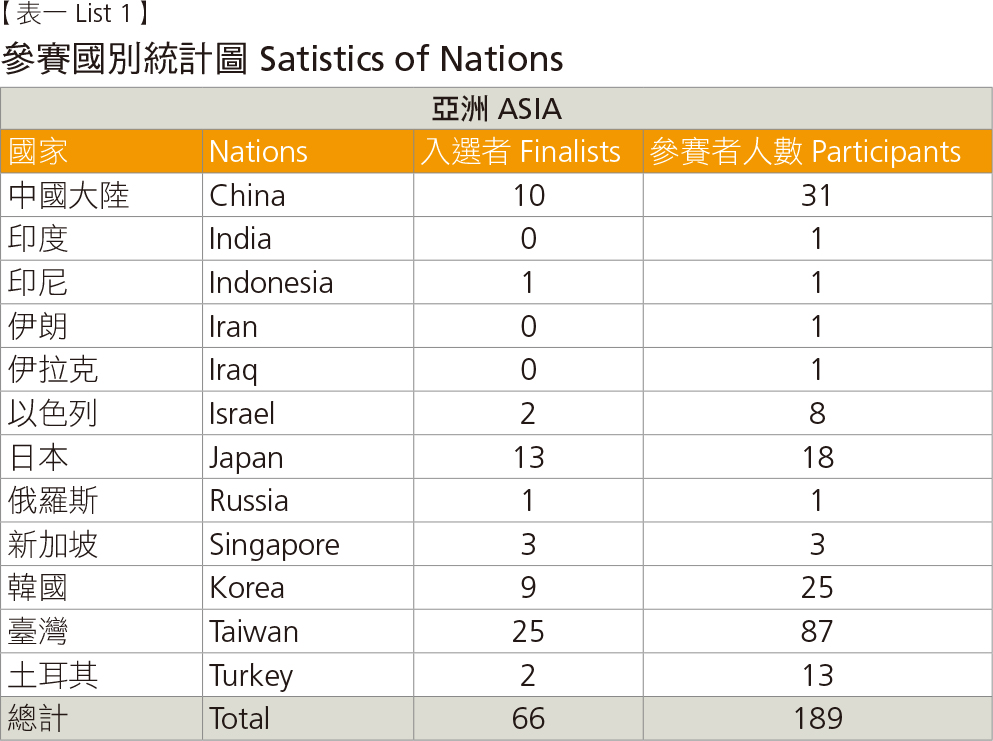
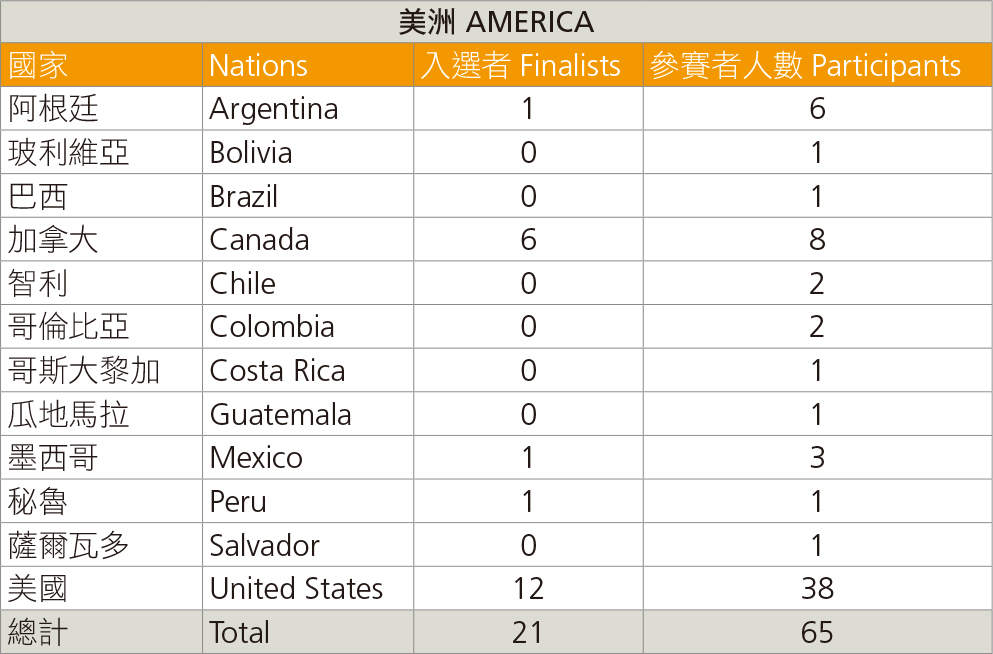
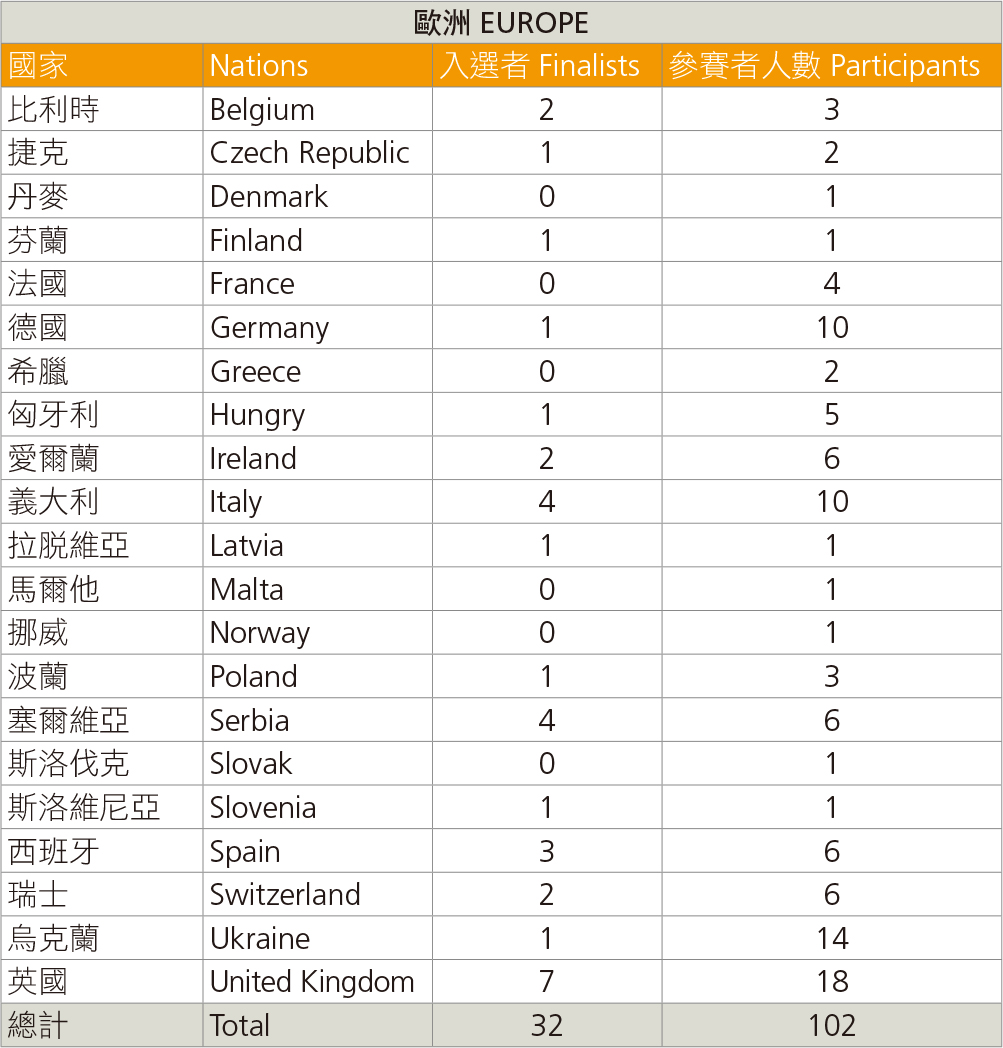


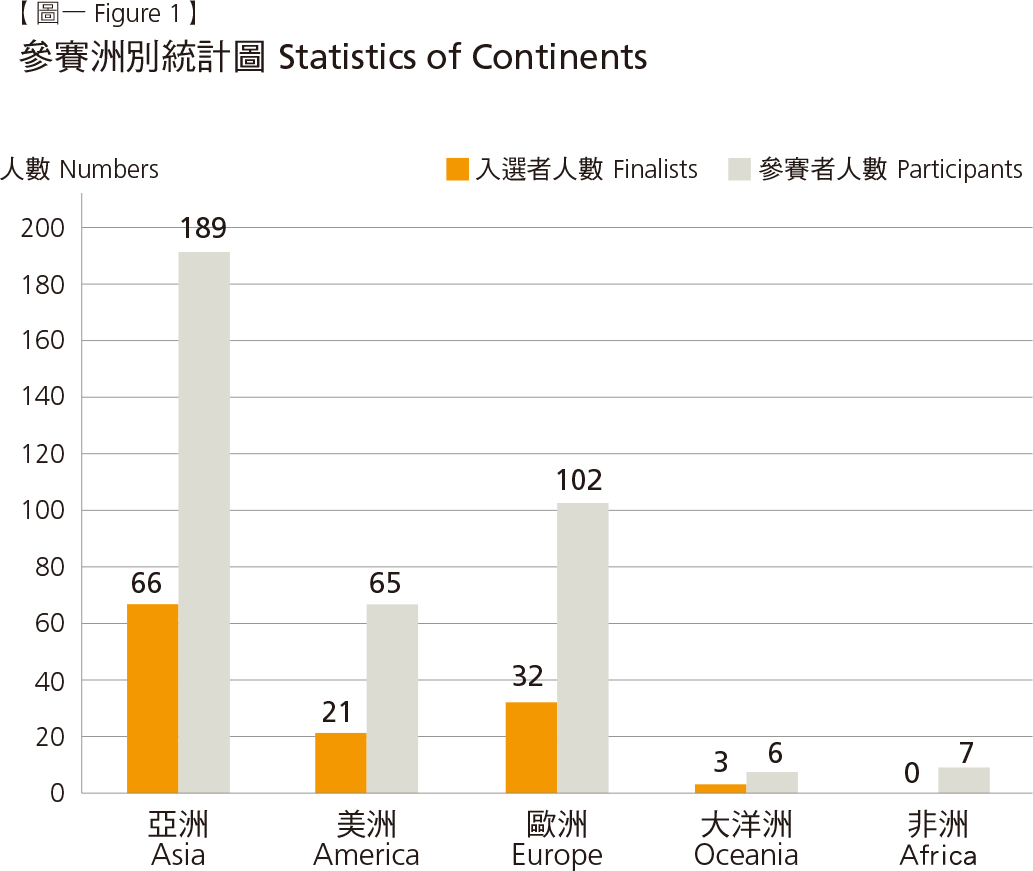
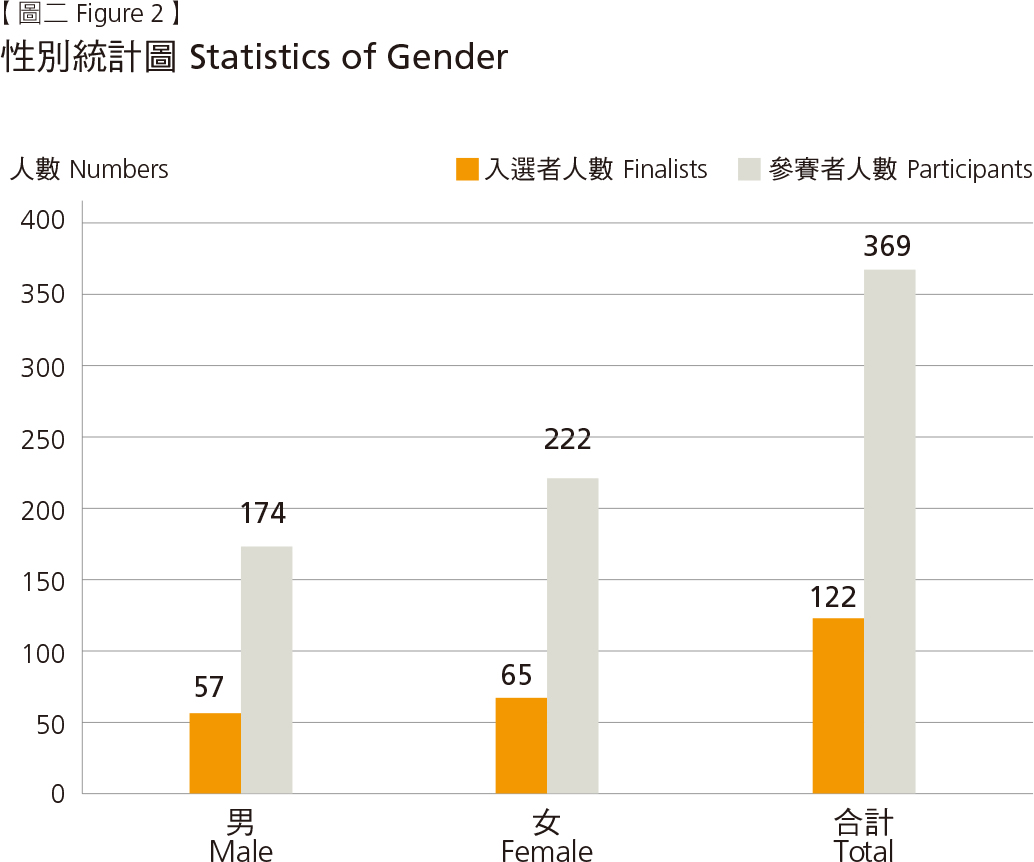
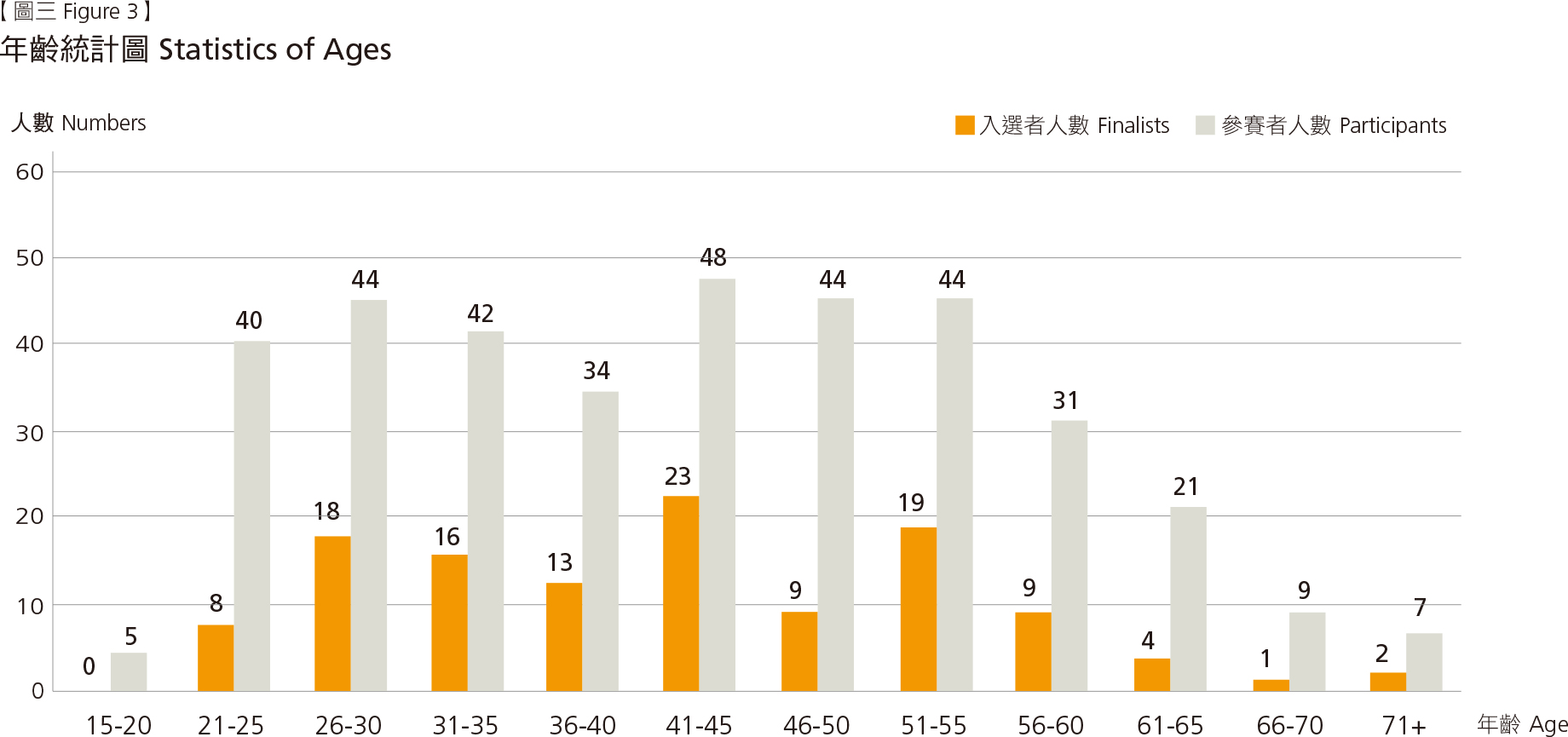
Art is a type of production activities in a society and culture. It is a medium for as well as experiential reflection of man’s interaction with the society, his environment and nature. For a creator, creation is an expression of what s/he thinks, how s/he feels and where s/he lives, the lexicon of his or her own. Today, art genres are hard to be defined. Ceramic art creation per se is done by artists from various fields across the world. Ceramics has evolved from utilitarian craftsmanship into pure fine art. Contemporary ceramic art has been enriched by diverse art experiences and techniques. Through artists’ observation, contemplation and creation, ceramic artwork gives an expression of its creator’s opinions on times, history and culture. Made of materials taken from nature, ceramic works of art may be seen as cultural products and social practices. Ceramic art has grown vigorously because of the expansion of its range, and its perspectives are more diversified because of the nature of materials and the uniqueness of techniques.
Contemporary ceramic art is a form of art developed from traditional ceramics. Artists explore new creative possibilities among conventional pottery shapes. They give new life to objects. They extend their artistic energy, creativity and visions to their artwork. Whether an expression of tangible figure or intangible ideas, ceramic artwork is an articulation of vision and a practice of ideas. Those pieces of art are not merely some visible objects. They are also interpretations of ways of thinking about ceramic art and platforms where art collides and intertwines with the society, environment and public sphere. By observing, pondering, analyzing and reviewing their own culture, artists search for their core values, identities and cultural significance. Only when they come back to the very essence will they be able to thoroughly engage in independent thinking, to make decisions, to raise questions, and to change the status quote—which is one of the missions of art creation.
Whether in one piece or in multiple pieces, those works of art explore the nature of ceramics, creative expressions of ceramic art and traditional as well as innovative techniques to realize the richness and diversification of modern ceramic art. They concretely manifest the primary spirit of “ceramics” and the theme “Concept”. In addition, in recent years, many artists have paid close attention on expanding the boundaries of ceramic art, crossover art, breakthroughs of languages and forms of creative expression, searching for the application of new materials, and expanding the depth and width of ceramic creation. Yet those global trends in modern art also reveal the blurring lines and uncertainties of the homogeneity and heterogeneity of materials and those of crossover collaborations in ceramic art. Another concern worth examining is the global ceramic art talent gap. In any case, the diversification of modern ceramic art comes from artists who freely express their various ways of thinking through their own art languages. And that is exactly what Taiwan Ceramics Biennale would like to present through the means of international competition, in order to inspire new possibilities of ceramic art and other fields in Taiwan, to represent different ideologies, and to lead the general public to enter and experience the beauty of ceramic art.
This year’s Taiwan Ceramics Biennale, with a core structure centered on the theme “Concept”, has further categorized the 119 pieces of art into two sub-themes based on artist’s statements and forms of expression, in order to help the viewers to obtain a general understanding of the artwork and of the relationships among materials, functions, forms, space and creation concepts. The two sub-themes are “Ceramics Beyond Vessels” and “Concept Beyond Objects”. As a matter of fact, no categorization can fully describe the ideas and concepts of the artwork created. However it is still hoped that the sub-themes for and the visual display of the works of art may guide viewers in their appreciation, reflection and exchanging ideas as they navigate the world of those artists and learn the nature of the artwork and the trends of modern ceramic art.
Ceramics Beyond Vessels
Ceramics first appeared in human society as cooking utensils and containers for food, drink and storage. They have been functional and acted as important markers of the development of human society. Ceramic vessels have left people with impressions of ancient art, those of traditional forms, and something functional-oriented. However, with the evolution of history, of foreign economic and cultural exchanges, and of direct perception of beauty, ceramics has gradually become arts and crafts. Today, many artists try to break conventional boundaries with fresh ideas and to bring people new perspectives on ceramic vessels.
In this year’s Taiwan Ceramics Biennale, ceramics are elaborated in 42 works in a traditional perspective. It is translated into utilitarian craftsmanship in some of the works, or is combined with modern designs in some other works. Although those works of art are with different surface treatments, forms and structures, they all touch upon the dual roles of “vessels”—They have the look of functional containers but not in any commonly seen forms; meanwhile, they are also bearers of content, emphasizing discussion of the nature of ceramic art and typical images/thoughts of the existence of vessels. Whether the content which those works bear is tangible (solids or liquids) or intangible (cultural memory, sound, light, time, space and life experiences), the artists have made their efforts to give a visual form to their thoughts, to deconstruct the functional structure of vessels, and to reconstruct it into a new form.
Concepts Beyond Objects
Art to artists is language and words they use to communicate their messages and thoughts. Aristotle’s analysis of art and beauty indicates that artists reproduce the truth in front of their eyes, and record and convey their feelings, emotions, imagination and interpretation to their viewers in the form of shapes (tangible objects); and that art is a means of communication of information and ideas (abstract events, emotions and thinking) as well as an important medium connecting human beings and time, space, the environment and the earth. In this year’s Taiwan Ceramics Biennale, 77 pieces of art set forth object transformation. The artists of those pieces present tangible objects in unique forms. They interpret their thoughts by making use of mixed materials, glazes, colors, textures of clay, shapes and decorations, and present individual artistic objects that are seemingly abstract but concretely represent their creators’ ideas.
Those works accentuate the forms of organisms through the imitation of nature or life forms. They are symbols of their creators’ visual images, anamorphoses of the visible and concrete—such as soil, leaves, jungles, landscape, ocean, body and animal forms, or those of the invisible and abstract—such as cloud, wind, temperature, mist, and the future. They are the artists’ distinctive vocabulary to discuss topics like the impermanence of life, subjective consciousness and existence, introspection and the pursuit of desires.
Those works are abstract art with unique shapes, narrative as well as figurative, reflecting the landscape of the real world and the present. Some pieces raise multi-dimensional issues through the use of sculpting, engraving, shape, interdependence among heterogeneous materials and large volume installation. Some explore the art of geometry, the relationship between objects and ceramic art, or that between human beings and ceramic art through different forms, structures and visual expressions. Some depict scenes of everyday life or artist’s sentiments through visual representation of testimonies of life or nostalgic memories. Some reveal current social and cultural phenomena and present dialectics of nature and civilization. Still others study, record and reflect on ancient traditional cultures and aesthetics.
The participating artists, with their own specialties, show their cultural strengths and humanistic values in their artwork. They shape soil into distinct forms in their own languages of modern ceramic art, and through which different viewers gain different visual experiences due to different perceptions. In that context, an interactive relationship among art creation, content and viewer’s perception (cognition, sense and sensibility) is formed; and new concepts will emerge from the transition from sense to sensibility and the interaction between inner mind and external things.
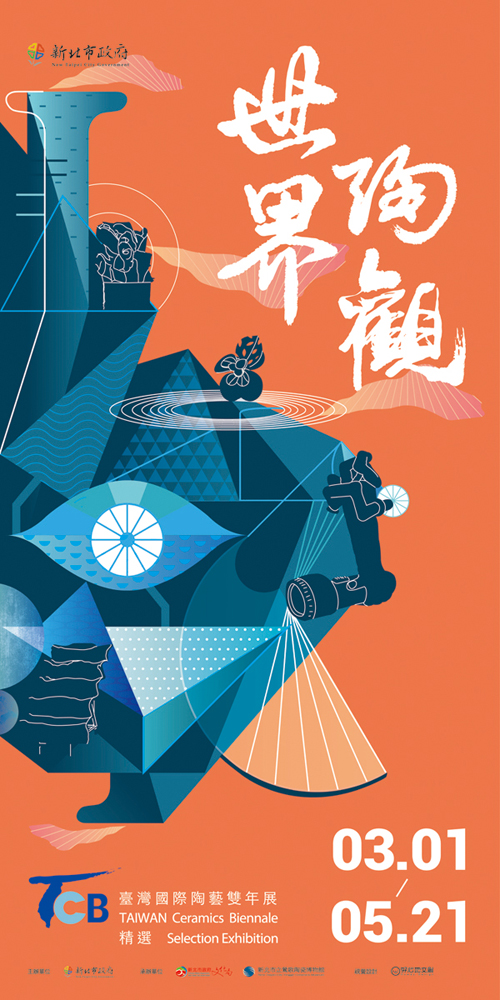
Date: 2016/3/1 ~ 5/21
Venue: New Taipei City Hall (No.161, Sec. 1, Zhongshan Rd, Banqiao District, New Taipei City 22001, Taiwan)
 主辦單位 | Organizer
主辦單位 | Organizer 承辦單位 | Executive Organizer
承辦單位 | Executive Organizer



